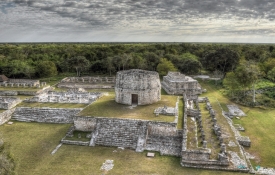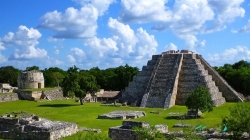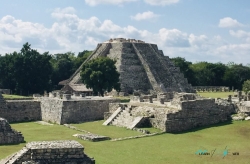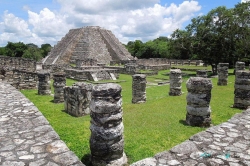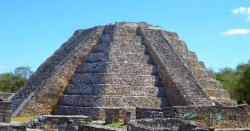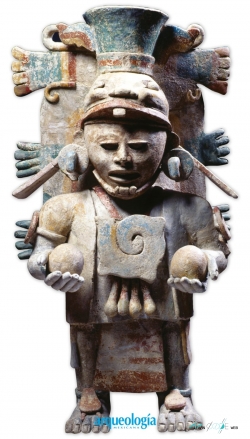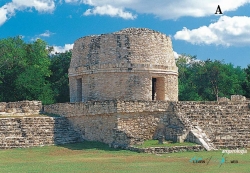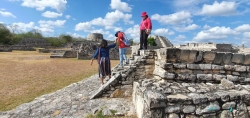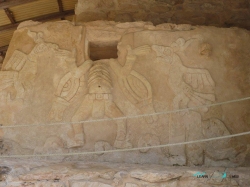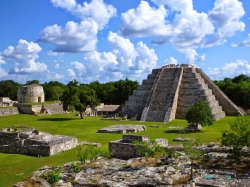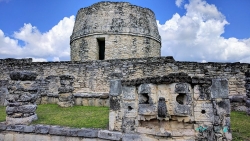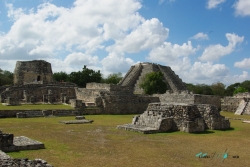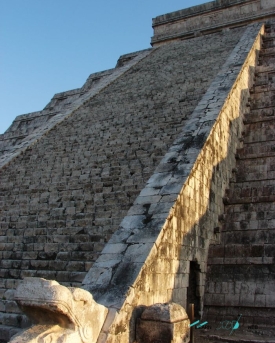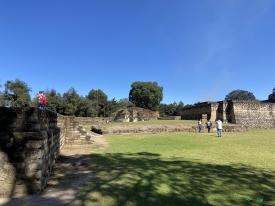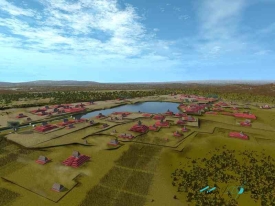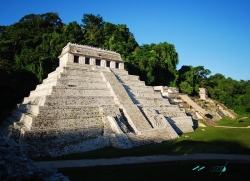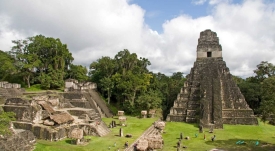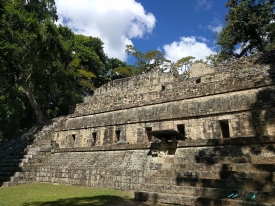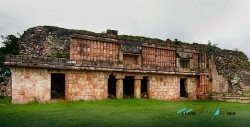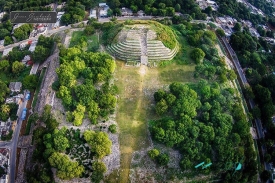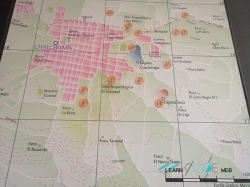ABOUT Archaeological site of Mayapan
Mayapan is a Pre-Columbian Maya site located in the state of Yucatán, Mexico. It was the political and cultural capital of the Maya in the Yucatán Peninsula during the Late Post-Classic period from the 1220s until the 1440s. Mayapan is a large and complex site, with over 4,000 structures within the city walls and additional dwellings outside. The site is known for its well-preserved ceremonial center, which features a number of temples, colonnaded halls, and other religious structures.
The lords divided the towns of Yucatán among them, and chose the chief of the Cocom family as their leader.
The Cocom family ruled Mayapan for over 200 years. During this time, the city became a powerful center of trade and commerce. Mayapan controlled a vast network of trade routes that extended throughout Mesoamerica. The city was also a major center of religious and cultural activity.
The Maya religion was polytheistic, and the Maya people worshipped a number of different gods and goddesses. Some of the most important Maya deities included Kukulkan/Quetzalcoatl, the god of wind and rain; Chac, the god of rain; and Itzamna, the creator god.
The Maya also developed a complex system of hieroglyphic writing. Maya writing was used to record religious texts, historical records, and astronomical observations.
The Temple of Kukulcan, a large pyramid also known as the Castillo, is the main temple in Mayapan. It is located immediately to the east of the Cenote Ch'en Mul, which has caves radiating from it. In form, the Temple of Kukulcan is a radial four-staircase temple with nine terraces; it is generally similar to the Temple of Kukulcan at the earlier site of Chichen Itza. However, the Mayapan temple appears to be an inferior imitation of the one at Chichen Itza, and the city's buildings in general are not constructed as well as those in other Mayan cities. For example, most or all of the vaulted roofs in Mayapan have collapsed, while many of the better-built buildings at Chichen Itza remain intact. Other major temples in the ceremonial center include three round ones, which are unusual for the Maya area and are also linked to the deity Kukulkan/Quetzalcoatl in his wind god (Ehecatl) aspect. Unlike Chichen Itza, Mayapan has no ballcourts.
The residential areas of Mayapan are also noteworthy. These areas are composed of dwellings and ancillary domestic structures, with those around the ceremonial district being larger and of higher quality. The houses are often arranged in small patio groups surrounding small courtyards.
History
The ethnohistorical sources recount multiple different histories of the rise and fall of Mayapan. These histories are often confusing, chronologically implausible, and difficult to reconcile. For example, some sources say that the Maya revolted in 1221 against the Maya-Toltec lords of Chichen Itza. After a short civil war, the lords of various powerful cities and families met to restore a central government to Yucatán. They decided to build a new capital city near the town of Telchaquillo, hometown of Hunac Ceel, the general who defeated the rulers of Chichen Itza. The new city was built within a defensive wall and named Mayapan, meaning "Standard of the Maya people".The lords divided the towns of Yucatán among them, and chose the chief of the Cocom family as their leader.
The Cocom family ruled Mayapan for over 200 years. During this time, the city became a powerful center of trade and commerce. Mayapan controlled a vast network of trade routes that extended throughout Mesoamerica. The city was also a major center of religious and cultural activity.
Culture
The Maya culture at Mayapan was a continuation of the Classic Maya culture that had flourished in the region centuries earlier. The Maya were skilled in agriculture, mathematics, astronomy, and writing. They also developed a complex system of religious beliefs and rituals.The Maya religion was polytheistic, and the Maya people worshipped a number of different gods and goddesses. Some of the most important Maya deities included Kukulkan/Quetzalcoatl, the god of wind and rain; Chac, the god of rain; and Itzamna, the creator god.
The Maya also developed a complex system of hieroglyphic writing. Maya writing was used to record religious texts, historical records, and astronomical observations.
Architecture
The architecture of Mayapan is similar to that of other Classic Maya sites, but there are also some unique features.The Temple of Kukulcan, a large pyramid also known as the Castillo, is the main temple in Mayapan. It is located immediately to the east of the Cenote Ch'en Mul, which has caves radiating from it. In form, the Temple of Kukulcan is a radial four-staircase temple with nine terraces; it is generally similar to the Temple of Kukulcan at the earlier site of Chichen Itza. However, the Mayapan temple appears to be an inferior imitation of the one at Chichen Itza, and the city's buildings in general are not constructed as well as those in other Mayan cities. For example, most or all of the vaulted roofs in Mayapan have collapsed, while many of the better-built buildings at Chichen Itza remain intact. Other major temples in the ceremonial center include three round ones, which are unusual for the Maya area and are also linked to the deity Kukulkan/Quetzalcoatl in his wind god (Ehecatl) aspect. Unlike Chichen Itza, Mayapan has no ballcourts.
The residential areas of Mayapan are also noteworthy. These areas are composed of dwellings and ancillary domestic structures, with those around the ceremonial district being larger and of higher quality. The houses are often arranged in small patio groups surrounding small courtyards.
Decline and Fall
Mayapan was abandoned in the mid-15th century, after a series of revolts by its subject cities. The reasons for the city's decline are not fully understood, but it is likely that a combination of factors, including political instability, environmental degradation, and economic decline, all played a role.Today
Today, Mayapan is a popular tourist destination. Visitors can explore the ruins of the city's ceremonial center and residential zones, as well as learn about the Maya culture and history at the on-site museum.The Best Pictures of Archaeological site of Mayapan
Videos of Archaeological site of Mayapan









